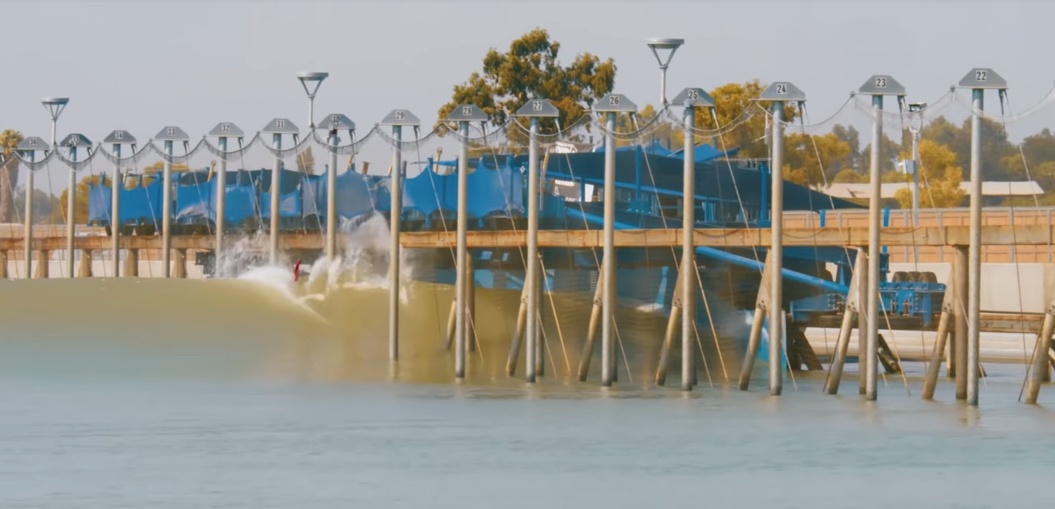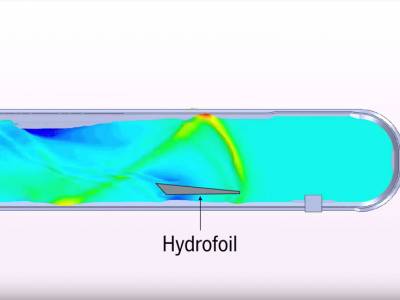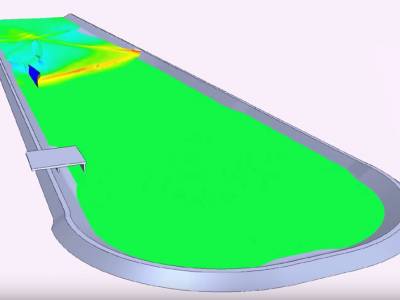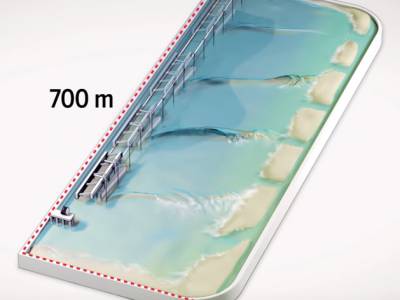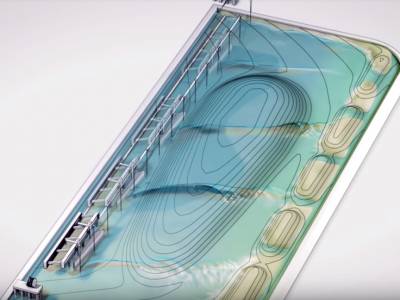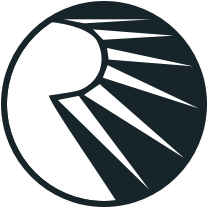Kelly Slater Wave Company
Kelly Slater Wave Co. Technology
The wave creation technology from Kelly Slater Wave Co. (KSWC) generates waves by driving a 100-ton foil through the water. The foil is attached to what the team calls “the vehicle" which sits on a track above the water. The vehicle gets moved up and down the track at 10 to 18 miles per hour by winches that sit at either end of the track. Electric motors power the winches. The winches are connected to the vehicle by cable. To generate a wave, the vehicle is pulled along the track and the foil is dragged through the water. As the foil moves through the water, it continually creates a wave that propagates toward the shoreline where it encounters shallower water and breaks.
The foil is bi-directional, meaning it can be pulled in both directions (north and south). When the foil moves one way, it creates a right hand wave and when the foil moves the other way, it creates a left.
Although little is known about the shape of the foil (e.g. its obstructed from view by tarps), Adam Fincham, the chief scientist on the team, said that the foil design was inspired by Derek Garard Goring, who developed a method of generating “very nice waves with a paddle.” Kelly has described the foil as an “really inefficient boat hull". However, what it lacks from a boaters perspective, it makes up from a surfer’s perspective: Kelly also says that 90% of the energy put into moving the foil is transferred into the water.
Wave Size and Shape
KSWC wave pool technology has demonstrated that it can create powerful head high+ waves offering barrel, turn and air opportunities that run left or right. Many people would argue it produces the most “perfect" waves of any wave pool technology, but depends on your perspective.
By changing the speed and angle of the foil, the controller can create variations of that “perfect" wave we’ve all seen. The controller can pick from several pre-programmed wave profiles, each with a different name. For example, “CT-3" is a particularly fast, hollow profile used for the ‘CT contests. The shape of the sections of the wave also varies with the bottom contours of the pool.
KWSC wave pool technology has also demonstrated the ability to create slower, smaller intermediate waves and rolling waves that can be shared by long boarders and beginners, but that’s not their sweet spot or intention.
Like most wave pool technology companies, the size of the wave depends on the installation. KSWC claims their technology can create waves as big as 7.5. The KSWC installation at the Surf Ranch produces waves up to 6′ high on the face.
The length of ride on a wave generated by KWSC technology is directly correlated to the length of the pool. Theoretically, with a long enough pool, waves could run for an indefinite amount of time. The installation at the Surf Ranch produces waves that can be ridden up to 45 seconds.
Read More
Productivity and Capacity
The frequency of wave generation depends on how much time the operator allows for the water to settle, and settling time depends on the size of the wave created and the size of the pool. At the Surf Ranch, they typically wait around 3-4 minutes between waves. At future installations, like Surf Ranch Coolum, we suspect the KSWC team to reduce settling time by increasing pool size and adding secondary waves to help absorb energy.
Each wave generated in a KSWC pool is intended to be ridden by one person. However, if the pool is long enough, waves can be split so that one surfer rides the first half and another rides the second half. This happens by design at the Surf Ranch in Lemore on occasion. As mentioned above, we expect future KSWC installations to create a wider pool with secondary waves reformed to allow more people to ride each wave generated.
KSWC pools can generate rolling waves that can be shared by long boarders and beginners, but that’s not their sweet spot or intention.
The Pool
The KSWC tech can be applied to pools larger than 500m. The pool at the Surf Ranch in Lemore is 700 meters long and 150 meters wide, and at its deepest point its only 9 feet deep. The wave breaks in 3 to 4 feet of depth, so its not uncommon to hit the bottom and/or get held down while you get swept along with the wave. The pool bottom at the Surf Ranch is concrete and lined with at tarp.
Minimizing settling time is a critical part of wave generation technology. KSWC uses gutters running the length of the pool capture the water and energy that comes from a wave to help reduce the settling time. We suspect they will use a different or expanded approach in the future to help reduce settling time and increase productivity.
Controlling KWSC Wave Pools
KSWC wave pools are controlled by a person sitting in a control tower overlooking the pool. As mentioned above, the controller can pick from a variety of different wave profiles, each with a different size and shape. The variations are generated by changing the speed and angle of the foil.
With the click of the blue “Launch Confirm" button seen on the Siemens-made control system above, the operator in the control tower can launch a wave.
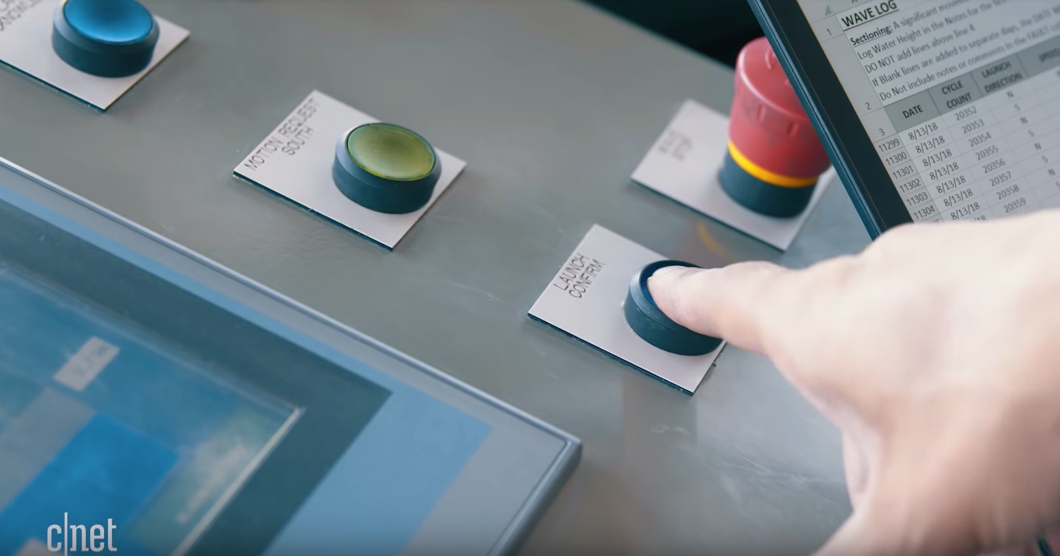
Power Consumption
The KWSC team has never revealed information about the power consumption of their technology. However, there has been some online research and speculation.
Taylor Lobdell from Surfheater teamed up with a friend who’s familiar with physics and came to the conclusion that it took 7.4kWh to move the foil one length of the pool. If that seems small, you are not the only one… that figure was quickly shot down on Reddit and other places.
In a Wired article, Doug Coors said NLand requires the power equivalent of 10 V6 engines to move their foil through the water. Nland creates smaller waves but they create them on both sides of the foil, so the Lemore installation could be in the same ballpark.
Wave Pools Powered by KSWC Technology
Highlights and Lowlights
| Arguably the most powerful, perfect wave in a wave pool. | |
| Longest waves created in a wave pool. |
| Wave production rate is relatively low due to settling time. | |
| Rides per surfer per hour is relatively low. |

